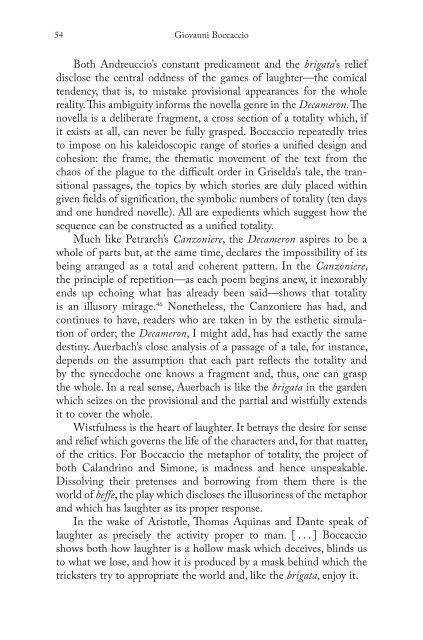Blooms Literary Themes - THE TRICKSTER.pdf - ymerleksi - home
Blooms Literary Themes - THE TRICKSTER.pdf - ymerleksi - home
Blooms Literary Themes - THE TRICKSTER.pdf - ymerleksi - home
Create successful ePaper yourself
Turn your PDF publications into a flip-book with our unique Google optimized e-Paper software.
54<br />
Giovanni Boccaccio<br />
Both Andreuccio’s constant predicament and the brigata’s relief<br />
disclose the central oddness of the games of laughter—the comical<br />
tendency, that is, to mistake provisional appearances for the whole<br />
reality. Th is ambiguity informs the novella genre in the Decameron. Th e<br />
novella is a deliberate fragment, a cross section of a totality which, if<br />
it exists at all, can never be fully grasped. Boccaccio repeatedly tries<br />
to impose on his kaleidoscopic range of stories a unifi ed design and<br />
cohesion: the frame, the thematic movement of the text from the<br />
chaos of the plague to the diffi cult order in Griselda’s tale, the transitional<br />
passages, the topics by which stories are duly placed within<br />
given fi elds of signifi cation, the symbolic numbers of totality (ten days<br />
and one hundred novelle). All are expedients which suggest how the<br />
sequence can be constructed as a unifi ed totality.<br />
Much like Petrarch’s Canzoniere, the Decameron aspires to be a<br />
whole of parts but, at the same time, declares the impossibility of its<br />
being arranged as a total and coherent pattern. In the Canzoniere,<br />
the principle of repetition—as each poem begins anew, it inexorably<br />
ends up echoing what has already been said—shows that totality<br />
is an illusory mirage. 46 Nonetheless, the Canzoniere has had, and<br />
continues to have, readers who are taken in by the esthetic simulation<br />
of order; the Decameron, I might add, has had exactly the same<br />
destiny. Auerbach’s close analysis of a passage of a tale, for instance,<br />
depends on the assumption that each part refl ects the totality and<br />
by the synecdoche one knows a fragment and, thus, one can grasp<br />
the whole. In a real sense, Auerbach is like the brigata in the garden<br />
which seizes on the provisional and the partial and wistfully extends<br />
it to cover the whole.<br />
Wistfulness is the heart of laughter. It betrays the desire for sense<br />
and relief which governs the life of the characters and, for that matter,<br />
of the critics. For Boccaccio the metaphor of totality, the project of<br />
both Calandrino and Simone, is madness and hence unspeakable.<br />
Dissolving their pretenses and borrowing from them there is the<br />
world of beff e, the play which discloses the illusoriness of the metaphor<br />
and which has laughter as its proper response.<br />
In the wake of Aristotle, Th omas Aquinas and Dante speak of<br />
laughter as precisely the activity proper to man. [ . . . ] Boccaccio<br />
shows both how laughter is a hollow mask which deceives, blinds us<br />
to what we lose, and how it is produced by a mask behind which the<br />
tricksters try to appropriate the world and, like the brigata, enjoy it.

















